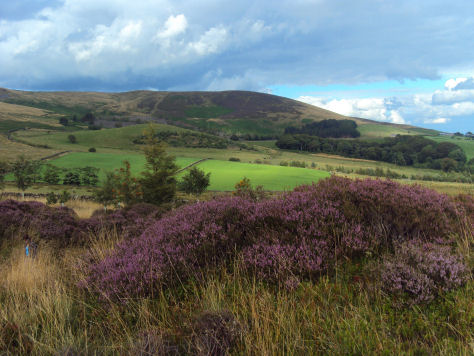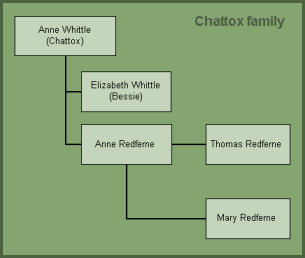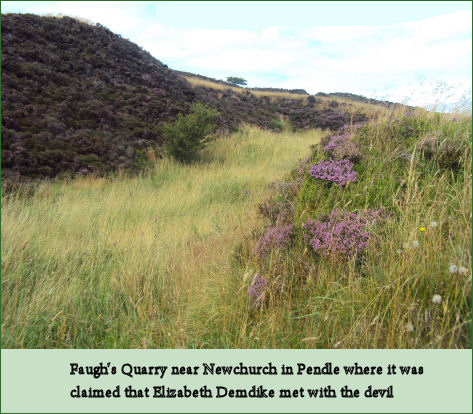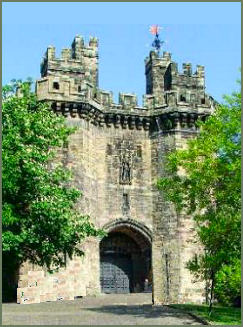The Pendle Witches
 The notorious Pendle witch trials of 1612 are among the most famous witch trials in English history. Twelve people from the area around Pendle Hill in Lancashire were charged with the murder, by witchcraft.
The notorious Pendle witch trials of 1612 are among the most famous witch trials in English history. Twelve people from the area around Pendle Hill in Lancashire were charged with the murder, by witchcraft.
King James I of Scotland, a firm believer in witchcraft, succeeded to the English throne on the death of his cousin, Elizabeth I in 1603. Following a visit to Denmark, James followed the 1590 trial of the North Berwick witches with interest, the North Berwick witches involved in the trial were accused of using witchcraft to stir up a storm against the ship that carried James and his bride, Anne of Denmark back to Scotland. He was also the author of a book on witchcraft entitled Daemonologie. A year after James' succession to the English throne, a law was passed which imposed the death penalty in cases where it could be proven that death or harm had been caused through witchcraft.
 In 1612, each justice of the peace in Lancashire was ordered by the government to provide a list of recusants, those who refused to attend Church of England services in their area. Roger Nowell, J.P. for the Pendle area, lived at Read Hall, on the edge of Pendle Forest. Whilst searching out nonconformists, in March 1612, he investigated a complaint made by the family of John Law, who claimed to have been injured by means of witchcraft.
In 1612, each justice of the peace in Lancashire was ordered by the government to provide a list of recusants, those who refused to attend Church of England services in their area. Roger Nowell, J.P. for the Pendle area, lived at Read Hall, on the edge of Pendle Forest. Whilst searching out nonconformists, in March 1612, he investigated a complaint made by the family of John Law, who claimed to have been injured by means of witchcraft.
Law, a pedlar from Halifax, encounterered a certain Alizon Device, when on her way to Trawden Forest, Alizon asked the pedlar for some pins, however he refused to open his pack for such a small purchase. Law later suffered a seizure, and acredited this to Alizon's curse on him. Alizon Device, reportedly later confessed to Nowell of using witchcraft against Law:-
'At which time this examinate (Alizon Device) met with a pedler on the high-way, called Colne-field, neere unto Colne: and this examinate demanded of the said pedler to buy some pinnes of him; but the said pedler sturdily answered this examinate that he would not loose his packe; and so this examinate parting with him. Presently there appeared to this examinate the blacke dogge, which appeared unto her as before, which black dogge spake unto this examinate in English, saying; "what wouldst thou have me to do unto yonder man?", To whom this examinate said, "what canst thou do at him?." And the dogge answered againe, "I can lame him", whereupon this examinate answered, and said to the said black dogge, "lame him". And before the pedler was gone fortie roddes further, he fell downe lame and this examinate then went after the said pedler, and in a house about the distance aforesaid, he was lying lame, and so this examinate went begging in Trawden forest that day, and came home at night. And about five dayes next after, the said black-dogge did appeare to this examinate, as she was going a-begging, in a close neere the new-church in Pendle, and spake againe to her, saying; "stay and speake with me", but this examinate would not. Sithence which time this examinate never saw him'.
 Alizon Device, her mother Elizabeth, and her brother James were accordingly summoned to appear before Roger Nowell on 30th March 1612. Alizon confessed that that she had asked the devil to lame John Law, James Device informed Nowell that his sister had also confessed to bewitching a local child. Elizabeth admitted that her mother, Elizabeth Southern, known as Old Demdike, had a mark on her body, regarded in those superstitious times of association with the feeding of imps or familiars and taken for a sure sign that an individual was a witch..
Alizon Device, her mother Elizabeth, and her brother James were accordingly summoned to appear before Roger Nowell on 30th March 1612. Alizon confessed that that she had asked the devil to lame John Law, James Device informed Nowell that his sister had also confessed to bewitching a local child. Elizabeth admitted that her mother, Elizabeth Southern, known as Old Demdike, had a mark on her body, regarded in those superstitious times of association with the feeding of imps or familiars and taken for a sure sign that an individual was a witch..
 When questioned about Anne Whittle (Chattox), the head of the other family reputed to have been involved in witchcraft in the Pendle area, Alizon perhaps saw an opportunity for revenge on an old enemy. The Demdikes and the Chattoxes were two rival peasant families who lived on the slopes of Pendle Hill. The men of both families were dead, leaving them poverty stricken. It is likely, though unproven, that the old women may have traded on their reputations to extort a living from their frightened neighbours.
When questioned about Anne Whittle (Chattox), the head of the other family reputed to have been involved in witchcraft in the Pendle area, Alizon perhaps saw an opportunity for revenge on an old enemy. The Demdikes and the Chattoxes were two rival peasant families who lived on the slopes of Pendle Hill. The men of both families were dead, leaving them poverty stricken. It is likely, though unproven, that the old women may have traded on their reputations to extort a living from their frightened neighbours.
Alizon reported that Chattox had murdered four men by witchcraft, and further accused her of being responsible for the death of her father, John Device, in 1601, whom on his deathbed, claimed that his illness was a the result of witchcraft. She further stated that Demdike had been asked to heal a sick cow which then died and that she had cursed Richard Baldwin after which his daughter fell sick and died a year later. She described her family's feud with the Chattox family and stated that Chattox turned the ale sour at an Inn at Higham and bewitched the landlord's son to death using a clay image.
On 2 April 1612, Old Demdike (Elizabeth Southerns) and Chattox (Anne Whittle), both in their eighties and blind, were questioned by Nowell, along Chattox's daughter Anne Redferne. Demdike confessed that she had given her soul to the Devil 20 years previously, Chattox confessed to having to a 'familiar spirit' that went by the name of 'Fancie'. It was their testomony against one another that was a mainstay of the prosecution evidence that led to their downfall. Anne Redferne refused to confess, but Demdike reported that she had observed her making clay figures. Nowell committed Demdike, Chattox, Anne Redferne and Alizon Device to Lancaster Castle.
Elizabeth Device organized a meeting of family and local sympathisers at Malkin Tower, the Demdike home near Newchurch-in- Pendle, on Good Friday, 6th April 1612, to dicuss how the accused families could be helped. On being informed of this, Nowell, suspected the meeting of being a Witches Coven and decided to investigate further. On 27th April 1612, an inquiry was held to determine the purpose of the meeting at Malkin Tower. at which eight further people, Elizabeth Device, James Device, Alice Nutter, Katherine Hewitt, John Bulcock, Jane Bulcock, Alice Gray and Jennet Preston, were accused of witchcraft and committed for trial at Lancaster Castle. (pictured below left)
 Jennet Device, aged nine, became a key witness for the prosecution, giving evidence against her mother and other members of her family. None of the accused were provided with a defence lawyer. Alizon Device fainted when confronted with the pedlar she was accused of having lamed, Elizabeth Device cursed her court in front of the courtand had to be removed from the courtroom by the bailiff. The aged Chattox wept when she heard the evidence against her and pleaded for mercy to be shown to her daughter, Anne Redfearn. Nine of the accused, namely Alizon Device, Elizabeth Device, James Device,
Anne Whittle, Anne Redferne, Alice Nutter, Katherine Hewitt, John Bulcock and Jane Bulcock, were found guilty of various crimes of witchcraft during the two-day trial, "By devilish practices and hellish means" bewitching sixteen inhabitants of the Forest of Pendle and a plot to blow up Lancaster Castle.
Jennet Device, aged nine, became a key witness for the prosecution, giving evidence against her mother and other members of her family. None of the accused were provided with a defence lawyer. Alizon Device fainted when confronted with the pedlar she was accused of having lamed, Elizabeth Device cursed her court in front of the courtand had to be removed from the courtroom by the bailiff. The aged Chattox wept when she heard the evidence against her and pleaded for mercy to be shown to her daughter, Anne Redfearn. Nine of the accused, namely Alizon Device, Elizabeth Device, James Device,
Anne Whittle, Anne Redferne, Alice Nutter, Katherine Hewitt, John Bulcock and Jane Bulcock, were found guilty of various crimes of witchcraft during the two-day trial, "By devilish practices and hellish means" bewitching sixteen inhabitants of the Forest of Pendle and a plot to blow up Lancaster Castle.
Only hours after being sentenced they were hanged at Gallows Hill in Lancaster on 20th August 1612, Elizabeth Southerns (old Demdike) died while awaiting trial. Jennet Preston was similarly sentenced at York, only one of the accused, Alice Grey, was found not guilty.
An account of the proceedings was published in November 1612, some three months after the executions, in a book entitled "The Wonderful Discoverie of Wtiches in the Countie of Lancaster" by Thoman Potts who was clerk to the Judges of Lancaster Assize of 1612
Almost four hundred years later, in 2011, a seventeenth century cottage was discovered by water engineers from United Utilities during a routine construction project. The cottage (pictured right) lay under a grass mound near Lower Black Moss reservoir in the village of Barley, in the shadow of Pendle Hill. It is thought that it could have been the home of one of the Pendle witches.
The building contained a sealed room, where the bones of a cat where discovered bricked into the wall by archaeologists. It is believed the cat was buried alive to protect the cottage's inhabitants from evil spirits.
